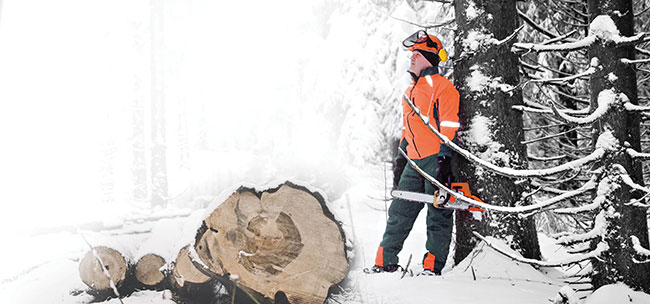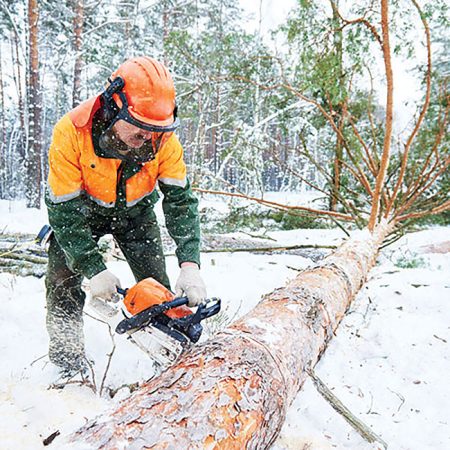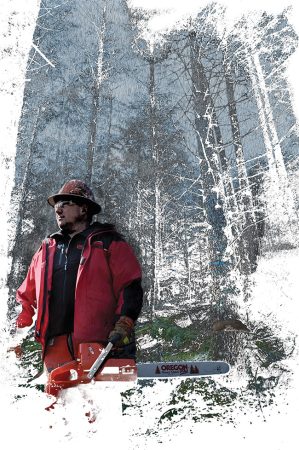
Features
Cutting in the cold
Maintenance is key when operating chainsaws in the winter
November 14, 2022 By Glenn Lovell
 Before operating a chainsaw in the winter, make sure you understand how cold weather affects your equipment.
Before operating a chainsaw in the winter, make sure you understand how cold weather affects your equipment. Operating during the winter months undoubtedly has its challenges.
It’s important for loggers and foresters to be prepared when they’re cutting in the cold, and preparation may be even more important this year.
The Farmer’s Almanac is predicting an unseasonably cold winter with areas across Canada receiving significant amounts of snow, sleet, ice and rain.
That’s not to say that there aren’t benefits to cutting in the cold.
Logging when the ground is frozen or covered in packed snow reduces the chance of soil damage, like ruts and erosion, from the movement of heavy machinery.
There is also less chance of insects or fungi spoiling cut timber during winter.
Before operating a chainsaw in the winter, make sure you understand how cold weather affects your equipment.

Safety should be the priority for every job and project – even more so in winter.
Proper preparation and maintenance will keep your saw running efficiently, which can save you time and money in the long run.
Plus, properly maintained equipment is safer to operate.
- Tips for maintaining your chainsaw during winter months
Oregon Products is familiar with the challenges of cold-weather cutting, being a manufacturer of parts and tools that loggers and foresters use for 75 years, so here are our top tips for properly maintaining and operating your chainsaw during cold temperatures. - Use thinner oil. Liquid thickens in cold temperatures. During winter, either use a lighter-weight bar-chain oil or dilute your oil by 25 per cent with clean kerosene or diesel oil to prevent congealing. Keep an eye on your chain while operating in cold temperatures to make sure that it’s receiving enough oil from the saw for adequate lubrication to lessen the chance of throw-off.
- Check depth gauges. Every time you sharpen your saw chain, inspect the height of the leading portion of each cutter, also known as the depth gauge. When necessary, file down the depth gauge, as cold and hardened winter wood makes cutters more prone to wear.
- Maintain sharpened cutters. When operating in cold temperatures, cutters should be touched up with a high-quality saw chain file at least every hour, or more often as needed. Never force a dull chain to cut, especially when operating in frigid temperatures — and beware that ice and frozen wood may increase wear and tear on the chain.
- Inspect chain tension. Frequently check and adjust your chain’s tension to ensure it is correctly tightened on your bar. In frigid temperatures, chains typically contract, which can lead to long-term damage to your bar.
- Examine the bar. Just as you rotate your mattress or the tires on your car, you can and should turn over the symmetrical bar to ensure equalized rail wear. Also, remove any winter debris or snow to keep the bar groove clean and oil holes open for optimal performance.
- Keep an eye on the drive sprocket. The drive sprocket should be replaced every two chains, or sooner if wear is evident. Keep the sprocket cover clean to prevent moisture and snow from collecting in that area.
- Clear air intake. When operating in snowy conditions, make sure your saw’s air intake is kept clear. Snow and ice can plug the air intake and cause the saw to overheat. If snow covers your saw’s air filter or if your filter gets too wet from melted snow, you may also experience trouble with air flow. Regularly brush off your saw and clear any accumulated snow to keep it running in tip-top shape.
- Take care when fueling up. Before you refill your saw’s gas tank, brush off all snow and ice. Water — or melted snow — will steam and not ignite, causing your saw to sputter. Plus, water left in your saw can cause rusting over time.

It’s important to understand how Canada’s cold and snowy winters will affect the way your chainsaw operates. Photos courtesy of Oregon Tools.
Consider how winter affects safety practices
In addition to making sure your equipment is ready for the winter weather, also take the time to brush up on your safety practices.
Safety should be the priority for every job and project – even more so in winter.
Even softer types of wood like pine and spruce become more brittle and are more likely to splinter in cold temperatures. This makes eye and face protection when sawing even more important. With snow and ice present, waterproof chaps and gloves are essential for battling the elements – and protecting your limbs, given that chilly temperatures can also slow reflexes and action time. Be realistic about your experience and don’t operate a chainsaw in a situation you’re uncomfortable with or can’t concentrate in.
It’s important to understand how Canada’s cold and snowy winters will affect the way your chainsaw operates to ensure you’re cutting efficiently and safely. Following these tips will help you maintain your chainsaw through frigid temperatures and ensure it continues running for well beyond the winter.
Glenn Lovell is the senior technical services technician at Oregon Tool.
Print this page